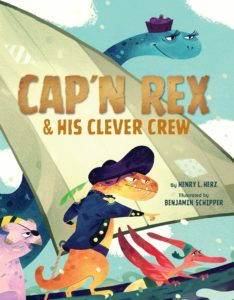“Cap’n Rex’s Steps to Writing a Fictional Picture Book”
Today, author Henry Herz joins us. His picture books include: MONSTER GOOSE NURSERY RHYMES, WHEN YOU GIVE AN IMP A PENNY, MABEL & THE QUEEN OF DREAMS, AND LITTLE RED CUTTLEFISH. His latest, just out from Sterling, is CAP’N REX & HIS CLEVER CREW. The protagonist, Cap’n Rex, has agreed to offer advice about how to get classrooms excited about a writing assignment, and some of the other things they will learn along the way. Please welcome, Cap’n Rex.
Arrr! It’s a pleasure to be aboard, me lasses. I may be a long-in-the-tooth dinosaur pirate, but I’ve a mess o’ experience teaching wee sailors how to write fictional picture books. It keeps ’em from getting bored on our long sea voyages. There be seven steps on my map to the buried treasure of children’s literacy. Read on, if ye dare!
- Form crews – Arrr, there be nothin’ like a little friendly competition to inspire performance. Arrange yer students into teams o’ four. Have each team pick a name. Some o’ me favorites arrr Mystery Marauders, Biography Buccaneers, and Paranormal Pirates. But, I may be biased toward piratey appellations. Each team’ll be writing their own picture book. Savvy?
- Define the details – Have each team parley among themselves to figger out the story elements listed below. This here be a bonus learning opportunity to teach them some writing concepts.
- Main character – What is the main character’s name, race/species, gender, title/role, and personality traits?
- Other characters – Do the same for yer other characters. Limit yerself to no more than four characters in all.
- Theme – If yer story will offer a lesson for the reader, what is it? Fer example, do unto others as you’d have others do unto you, or think outside the box.
- Goal/obstacles – Stories are more fun if there’s tension. What goal is the main character trying to reach (in my case, it’s usually booty). And what obstacle(s) must he or she overcome to reach that goal? One tried and true formula is: try-fail, try-fail, try-succeed. That makes victory all the sweeter, me buccos.
- Time frame – Will yer story take place in the past, present, or future? How far back in the past or into the future?
- Setting – Where will your tale unfold? On the high seas? In yer backyard? On Mars? In an ant hill?
- Genre – Will yer tale be fantasy, science fiction, mystery, historical, comedy, romance, horror, tragedy, or somethin’ else?
- Point of view – Does it work better if the tale be told by the main character or by a narrator?
- Tense – Should the tale be told in the present tense, as if it’s happening right now? Or, would it be better described in the past tense as something that’s already happened?
- Tell yer tale – Fictional picture books can have anywhere from zero (it’s true!) to 1,000 words. Aim fer about 500 words. Since there are often fourteen two-page “spreads”, that works out to an average of 36 words (three to four sentences) per spread. Picture books are usually written fer three to seven year-olds. So, make sure yer word choices are suitable for younger readers. Not too many syllables per word or words per sentence, or ye’ll walk the plank! Now yer teams can write their first draft of the manuscript.
- Time fer inspection – Just as dinosaur pirates have their work inspected by their handsome T-rex captain, yer young writers will need some guidance. Pair up yer teams. Have each member of one team read the other team’s story. Then, they offer feedback, alternating between things they liked about the story and things in the story that didn’t make sense or didn’t seem to help the story. Team members should not defend their writing. Just listen politely and take notes.
- Swab the deck – Just as a ship’s deck needs cleaning, so too does yer writin’. Now it be time for the teams to use the feedback they received to revise their story and make it seaworthy.
- Draw yer pictures – Now it be time to paint a pretty picture. A spread can be completely filled with a single illustration. Or, it can contain two to four smaller spot images. The latter is often used when the story pace has quickened. Give each team fourteen 11”x17” pieces o’ paper. Each team will divide their revised manuscript text up across the fourteen spreads. Then they’ll draw or paint pictures that help describe what is happening.
- Celebrate – Treats and grog (non-alcoholic) fer all when the stories be done! Each team takes turn reading their yarn to the class. Stories can be posted on the mainmast fer later parental enjoyment. What fine little writers ye arrr!
Cap’n Rex & His Clever Crew
Author: Henry L. Herz
Illustrator: Benjamin Schipper
Published August 1st, 2017 by Sterling Children’s Books
Shiver me timbers! It’s the DINOSAUR PIRATES!
Meet Captain Rex and his band of buccaneers. These dinosaur pirates sail the seven seas in search of buried treasure, but whenever they hit an obstacle—like a giant shark or pea-soup fog—the crew members are quick to say they can’t overcome. To this, Captain Rex just glares with teeth bared and says, “CAN’T YE?” And, somehow, the crew always comes up with a clever solution.
A delightful story about using one’s creativity and individual strengths to solve problems. It will encourage kids everywhere to think and say, “I can!”
Learn more about CAP’N REX & HIS CLEVER CREW and author Henry Herz at www.henryherz.com.
We Thank Ye fer Today’s Post, Cap’n Rex & Henry!


